Consumer-Goods
| | This section is empty. You can help by adding to it. (February 2015) |
High Strain Composite Structures (HSC Structures) are a class of composite material structures designed to perform in a high deformation setting. High strain composite structures transition from one shape to another upon the application of external forces. A single HSC Structure component is designed to transition between at least two, but often more, dramatically different shapes. At least one of the shapes is designed to function as a structure which can support external loads.
High strain composite structures usually consist of fiber-reinforced polymers (FRP), which are designed to undergo relatively high material strain levels under the course of normal operating conditions in comparison to most FRP structural applications. FRP materials are anisotropic and highly tailor-able which allows for unique effects upon deformation. As a result, many HSC Structures are configured to possess one or more stable states (shapes at which the structure will remain without external constraints) which are tuned for a particular application. HSC Structures with multiple stable states can also be classified as bi-stable structures.
HSC Structures are most often used in applications where low weight structures are desired that can also be stowed in a small volume. Flexible composite structures are used within the aerospace industry for deployable mechanisms such antennas or solar arrays on spacecraft. Other applications focus on materials or structures in which multiple stable configurations are required.
Metals commonly used in springs (e.g. high strength steel, aluminum and beryllium copper alloys) have been utilized in deformable aerospace structures for several decades with considerable success. [1] They continue to be used in the majority of high strain deployable structure applications and excel where the greatest compaction ratios and electrical conductivity are required. But metals suffer from having high densities, high coefficients of thermal expansion, and lower strain capacities when compared to composite materials. In recent decades, the increasing need for high performance deployable structures, coupled with the emergence of a robust composite materials industry, has increased the demand and utility for High Strain Composites Structures. Today HSCs are used in a variety of niche aerospace applications, mostly in areas where extreme precision and low mass are required.
In early 2014 the American Institute of Aeronautics and Astronautics Spacecraft Structures Technical Committee recognized that the level of active research and development in High Strain Composites warranted an independent focus group [2] to distinguish high strain composites as a technical area with uniquely identifiable challenges, technologies, mechanics, test methods, and applications. The High Strains Composite Technical Subcommittee was formed to provide a forum and framework to support HSC technical challenges and successes, and will promote continued advances in the field.
The use of high strain deployable structures dates back to the pioneering days of space exploration and has played a crucial role in enabling a robust spacefaring industry.
Milestones in Space-Based Deformable Structures
| Structure Common Name | Material | Development History | Flight History | References |
|---|---|---|---|---|
| Tape-Spring Hinge | Spring steel sheet | [3] [4] | ||
| Storable Tubular Extendible Mast (STEM) | Metal sheet | Developed by de Havilland Canada and Spar Aerospace Ltd. | 1961-AH2 Transit Research and Attitude Control (TRAAC), launched 1961. Alouette 1, launched in 1962 | [5] [6] [7] |
| Wrap Rib Antenna, C-Shaped Ribs | Aluminum sheet | Developed by Lockheed Missiles & Space Company starting in 1962 | ATS-6, launched in 1974. | [8] [9] |
| Lenticular Tube | Stainless steel sheet | Developed by NASA Lewis Research Center in 1965 | [10] | |
| Continuous Longeron Mast | S2 fiberglass rods | Developed by Astro Aerospace. | USAF S-3 Magnetometer Boom launched in 1974. | [11] |
| Lattice Lenticular Tube | Steel music wire | Developed by Astro Research Corporation in 1969. | [12] | |
| Wrap Rib Antenna, Lenticular Ribs | Glass fiber reinforced polymer laminate (Fiberite HMS/33) | Developed by Lockheed Missiles & Space Company in the 1970s; ground demonstration 1982. | [13] | |
| Spring Back Antenna Parabolic Reflector | Glass fiber reinforced polymer laminate | Mobile Sat-1, launched in 1996 | [14] [15] | |
| Foldable Flattenable Tubes | fiberglass and Kevlar laminate | Developed by TRW Astro Aerospace for MARSIS antennas, launched 2003 | Mars Express MARSIS antennas, launched in 2003 | [16] [17] |
| | This section is empty. You can help by adding to it. (February 2015) |
| | This section is empty. You can help by adding to it. (February 2015) |
Rigid Polymer
Rigidizable Polymer
Elastomeric Polymer
Creep
Thin Shell Buckling
Simulation Methods

Reinforced concrete (RC), also called reinforced cement concrete (RCC) and ferroconcrete, is a composite material in which concrete's relatively low tensile strength and ductility are compensated for by the inclusion of reinforcement having higher tensile strength or ductility. The reinforcement is usually, though not necessarily, steel bars (rebar) and is usually embedded passively in the concrete before the concrete sets. However, post-tensioning is also employed as a technique to reinforce the concrete. In terms of volume used annually, it is one of the most common engineering materials. In corrosion engineering terms, when designed correctly, the alkalinity of the concrete protects the steel rebar from corrosion.

A composite material is a material which is produced from two or more constituent materials. These constituent materials have notably dissimilar chemical or physical properties and are merged to create a material with properties unlike the individual elements. Within the finished structure, the individual elements remain separate and distinct, distinguishing composites from mixtures and solid solutions.
In materials science, superplasticity is a state in which solid crystalline material is deformed well beyond its usual breaking point, usually over about 600% during tensile deformation. Such a state is usually achieved at high homologous temperature. Examples of superplastic materials are some fine-grained metals and ceramics. Other non-crystalline materials (amorphous) such as silica glass and polymers also deform similarly, but are not called superplastic, because they are not crystalline; rather, their deformation is often described as Newtonian fluid. Superplastically deformed material gets thinner in a very uniform manner, rather than forming a "neck" that leads to fracture. Also, the formation of microvoids, which is another cause of early fracture, is inhibited.
In physics and materials science, elasticity is the ability of a body to resist a distorting influence and to return to its original size and shape when that influence or force is removed. Solid objects will deform when adequate loads are applied to them; if the material is elastic, the object will return to its initial shape and size after removal. This is in contrast to plasticity, in which the object fails to do so and instead remains in its deformed state.
Solid mechanics, also known as mechanics of solids, is the branch of continuum mechanics that studies the behavior of solid materials, especially their motion and deformation under the action of forces, temperature changes, phase changes, and other external or internal agents.
Fibre-reinforced plastic is a composite material made of a polymer matrix reinforced with fibres. The fibres are usually glass, carbon, aramid, or basalt. Rarely, other fibres such as paper, wood, or asbestos have been used. The polymer is usually an epoxy, vinyl ester, or polyester thermosetting plastic, though phenol formaldehyde resins are still in use.
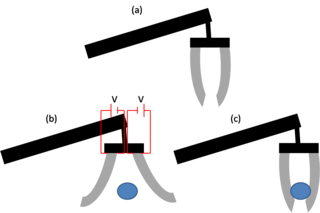
An electroactive polymer (EAP) is a polymer that exhibits a change in size or shape when stimulated by an electric field. The most common applications of this type of material are in actuators and sensors. A typical characteristic property of an EAP is that they will undergo a large amount of deformation while sustaining large forces.
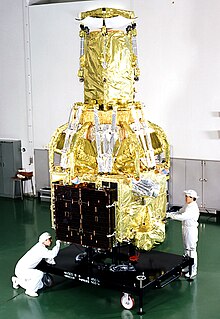
HALCA, also known for its project name VSOP, the code name MUSES-B, or just Haruka (はるか) was a Japanese 8 meter diameter radio telescope satellite which was used for Very Long Baseline Interferometry (VLBI). It was the first such space-borne dedicated VLBI mission.

ATS-6 was a NASA experimental satellite, built by Fairchild Space and Electronics Division It has been called the world's first educational satellite as well as world's first experimental Direct Broadcast Satellite as part of the Satellite Instructional Television Experiment between NASA and Indian Space Research Organisation (ISRO). It was launched May 30, 1974, and decommissioned July 1979. At the time of launch, it was the most powerful telecommunication satellite in orbit. ATS-6 carried no fewer than 23 different experiments, and introduced several breakthroughs. It was the first 3-axis stabilized spacecraft in geostationary orbit. It was also the first to use experimentally with some success electric propulsion in geostationary orbit. It also carried several particle physics experiments, including the first heavy ion detector in geostationary orbit.

A sandwich-structured composite is a special class of composite materials that is fabricated by attaching two thin but stiff skins to a lightweight but thick core. The core material is normally low strength material, but its higher thickness provides the sandwich composite with high bending stiffness with overall low density.
Shape-memory polymers (SMPs) are polymeric smart materials that have the ability to return from a deformed state to their original (permanent) shape when induced by an external stimulus (trigger), such as temperature change.
Polymer engineering is generally an engineering field that designs, analyses, and modifies polymer materials. Polymer engineering covers aspects of the petrochemical industry, polymerization, structure and characterization of polymers, properties of polymers, compounding and processing of polymers and description of major polymers, structure property relations and applications.
Carbon fiber-reinforced polymers, carbon-fibre-reinforced polymers, carbon-fiber-reinforced plastics, carbon-fiber reinforced-thermoplastic, also known as carbon fiber, carbon composite, or just carbon, are extremely strong and light fiber-reinforced plastics that contain carbon fibers. CFRPs can be expensive to produce, but are commonly used wherever high strength-to-weight ratio and stiffness (rigidity) are required, such as aerospace, superstructures of ships, automotive, civil engineering, sports equipment, and an increasing number of consumer and technical applications.
In materials science, advanced composite materials (ACMs) are materials that are generally characterized by unusually high strength fibres with unusually high stiffness, or modulus of elasticity characteristics, compared to other materials, while bound together by weaker matrices. These are termed "advanced composite materials" in comparison to the composite materials commonly in use such as reinforced concrete, or even concrete itself. The high strength fibers are also low density while occupying a large fraction of the volume.
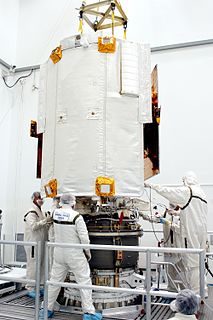
In spacecraft design, the function of the thermal control system (TCS) is to keep all the spacecraft's component systems within acceptable temperature ranges during all mission phases. It must cope with the external environment, which can vary in a wide range as the spacecraft is exposed to the extreme coldness found in the shadows of deep space or to the intense heat found in the unfiltered direct sunlight of outer space. A TCS must also moderate the internal heat generated by the operation of the spacecraft it serves. A TCS can eject heat passively through the simple and natural infrared radiation of the spacecraft itself, or actively through an externally mounted infrared radiation coil.
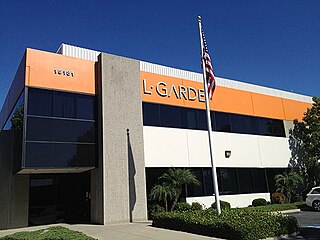
LGarde, also L'Garde or L·Garde, is an American aerospace and defense technology company founded in 1971 in Orange County, CA and is the primary contractor for the Sunjammer spacecraft, the world largest solar sail. The company was an early pioneer of thin-skinned, multi-task inflatable structures used in various military and space applications. At the height of the Cold War, L·Garde developed and manufactured inflatable targets and decoy systems for U.S. military defense, and countermeasure systems for the Strategic Defense Initiative. After the Cold-War, the company used the technologies and manufacturing techniques it had developed to land a contract to design and build the inflatable antenna experiment and other thin-film inflatable space structures using its unique application of rigidizable tube technology. The company's unusual name is an acronym formed by the initials of the founding partners: Bill Larkin, Gayle Bilyeu, Alan Hirasuna, Rich Walstrom, Don Davis. The "E" comes from the Latin term "et al" as a tip to other partners and original employees of the company.
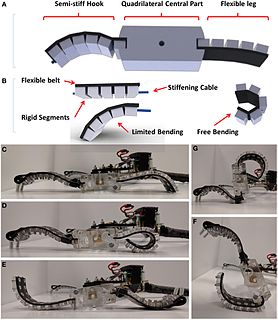
Soft robotics is a subfield of robotics that concerns the design, control, and fabrication of robots composed of compliant materials, instead of rigid links. In contrast to rigid-bodied robots built from metals, ceramics and hard plastics, the compliance of soft robots can improve their safety when working in close contact with humans.
Most of the terms listed in Wikipedia glossaries are already defined and explained within Wikipedia itself. However, glossaries like this one are useful for looking up, comparing and reviewing large numbers of terms together. You can help enhance this page by adding new terms or writing definitions for existing ones.

Wiesław Kazimierz Binienda is a Polish-American scientist, PhD, and professor and chairman of the Department of Civil Engineering at the University of Akron.
Redwire Corporation is an American aerospace manufacturer and space infrastructure technology company headquartered in Jacksonville, Florida. The company was formed on June 1, 2020 by the private equity firm AE Industrial Partners.
{{cite web}}: CS1 maint: archived copy as title (link)American Institute of Aeronautics and Astronautics, Structures Technical Committee Archived 2015-02-08 at the Wayback Machine , High Strain Composite Structures Subcommittee